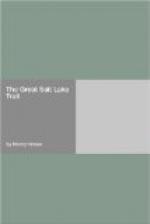not imagine what this meant, and withdrew into
the bluffs “to make it out,” as the old
trappers say.
Nelson was the first speaker, and he gave it as his opinion that Colonel Brown, who had told us before leaving camp he would soon start for the Solomon, had set out earlier than he expected, and was now crossing above us. I set my compass, and, finding we were nearly on the line where Brown would cross, readily fell in with Nelson’s reasoning. So sure was I that the guns we had heard were Colonel Brown’s soldiers out hunting that I proposed we should saddle up and go to them. This move came near proving fatal to us, as will presently appear. We rode boldly up the stream, in broad daylight, some five miles, when, not finding any trail, I began to express my surprise at the long distance we had heard the reports of the guns, but Nelson told me it was no uncommon thing, when snow was on the ground, to hear a rifle-shot ten to twenty miles along a creek bottom, and, incredible as this may seem, I found out afterward it was nevertheless true.
We rode on about five miles farther, when suddenly Nelson halted, and, pointing to an object a long distance ahead, said he believed it was a horseman. We lost no time in getting into the bluffs, where we could observe what went on without being seen, and soon saw an animal coming down the creek bottom. As it drew near, we discovered it to be a horse, evidently much frightened, and flying from pursuers. The horse galloped past, but stopped half a mile below us and quietly went to grazing, every now and then raising his head and looking up the creek, as if he expected to see some enemy following him. We lay for several hours momentarily expecting to see a body of Indians coming down the creek, but none came, and at noon Nelson said I should watch, and he would crawl down the creek and see if he could discover anything from the horse. I saw Nelson approach quite near the animal, and heard him calling it, when, to my surprise, it came up to him and followed him into the bluffs. The horse was the one Sergeant Hiles had ridden from the camp a few days previous, and was well known to Nelson and me as a superb animal, named Selim.
It did not take us long to come to the conclusion that Hiles and Rolla had been attacked, and that the firing we had heard in the morning was done by the Indians. From the fact that Hiles’ horse had no saddle on when found, we concluded he had been in the hands of the Indians, and had probably broken away from them, and we doubted not that at least Hiles was dead.
Fearing the savages would come down upon us next, we lost no time in getting down the creek. We soon passed where we had encamped the night before, and, finding the fire still burning, put it out, and, covering up the ashes, pushed on for several miles and camped among the bluffs. Nelson carried up several logs




